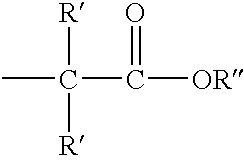Methods for sterilizing cyanoacrylate compositions
a technology of cyanoacrylate and composition, which is applied in the direction of dentistry, disinfection, printing, etc., can solve the problems of unsuitable or undesirable solid compositions, unsuitable conventional sterilization techniques, and unsuitable solid compositions for use as adhesives, etc., and achieve the effect of solidification of cyanoacrylate ester compositions at low temperatures and industrial production scales
- Summary
- Abstract
- Description
- Claims
- Application Information
AI Technical Summary
Problems solved by technology
Method used
Image
Examples
example 1
A two component skin prep is manufactured by placing 0.7 mL of n-butyl cyanoacrylate containing 500 ppm hydroquinone stabilizer, into a borosilicate glass ampoule which is then sealed with a gas flame. 40 sealed ampoules are placed in a PurePulse.TM. sterilizing apparatus that is part of the production line, and sterilized. The ampoules are then assembled into a dual chamber device such as described in U.S. Provisional Patent Application Serial No. 60 / 218979 (which is incorporated herein by reference in its entirety) with the ability to deliver a povidone iodine solution from one end and then cover it with a sealing coat of n-butyl cyanoacrylate delivered from the other end. The completed assembly is then incorporated into a procedure kit for use in an Operating Room, and the whole kit is sterilized using ethylene oxide gas.
example 2
LiquiSeal.TM., a polymerizable cyanoacrylate composition comprising n-butyl cyanoacrylate, is prepared by filling an injection molded high density polyethylene ampoule coated on the inner surface with a layer of silica, with 0.5 g of monomer formulation. The formulation consists of 1000 ppm hydroquinone and 1000 ppm of 4-methoxy phenol in an 80:20 mixture of n-butyl cyanoacrylate and diethylhexyl phthalate. The ampoule is heat sealed an packaged immediately with an application brush into a thin film polypropylene sleeve with inner silica coating. Ten of these assemblies are then placed in the PurePulse.TM. sterilization equipment and the product sterilized.
PUM
| Property | Measurement | Unit |
|---|---|---|
| wavelengths | aaaaa | aaaaa |
| pore size | aaaaa | aaaaa |
| temperatures | aaaaa | aaaaa |
Abstract
Description
Claims
Application Information
 Login to View More
Login to View More - R&D
- Intellectual Property
- Life Sciences
- Materials
- Tech Scout
- Unparalleled Data Quality
- Higher Quality Content
- 60% Fewer Hallucinations
Browse by: Latest US Patents, China's latest patents, Technical Efficacy Thesaurus, Application Domain, Technology Topic, Popular Technical Reports.
© 2025 PatSnap. All rights reserved.Legal|Privacy policy|Modern Slavery Act Transparency Statement|Sitemap|About US| Contact US: help@patsnap.com



